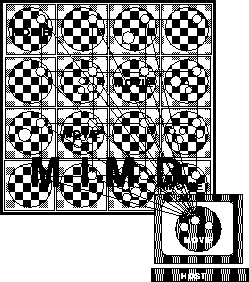




Next: 17.2.5 Distributed Computing
Up: 17.2 System Overview
Previous: 17.2.3 Data-Parallel Computing
The MIMD MOVIE model is illustrated in Figure 17.3.
Basically, MOVIE Server plays the role of the general purpose node
program or, rather, node operating shell. The MovieScript-based
communication model is constructed on top of the compiled
language-based communication library, provided either directly by the
hardware vendor or by one of the portable low-level models such as the
commercial Express package [ParaSoft:88a] or the public domain
PICL package [Geist:90b] described in Chapters 5 and
16. The MIMD operation of MOVIE can both support the
asynchronous problem class and mimic the message-passing model for
loosely synchronous applications.

Figure 17.3: Elements of the MIMD MOVIE Model. Each node runs
asynchronously an identical, independent copy of the multithreading
MOVIE Server, interpreting (a priori distinct) node MovieScript
programs and communicating with other modes via MovieScript messages.
Regular and irregular components can be time-shared as illustrated in
the figure. A single unique thread has been selected in each node (the
one in the upper right corner) for regular processing and the other
threads are participating in some independent or related irregular
tasks. The regular thread processing is based on the ``MovieScript +
message passing'' model, that is, all node programs are given by the
same code which depends only parametrically on the node number. The
mesh of regular threads is mapped on a single host thread which can be
considered, for example, as a matrix algebra accelerator ``board''
within some sequential or distributed Virtual Machine model, involving the host server.
The interesting features of such a model stem from the multithreading
character of the node program. The MIMD mesh of node servers can be
configured either in the fully asynchronous or the regular mode.
Various intermediate and/or mixed modes are also possible and useful.
The default mode is asynchronous-each server maintains its own thread
queue, executing individual thread programs and serving the communication
requests according to the software-clock-based preemptive scheduling model.
The system operation in this mode is similar to the distributed computing
model and is discussed in more detail in Section 17.2.5.
The simplest way to enforce the regular mode is by retaining only one thread
in each node server and by following the conventional ``MovieScript + message
passing'' loosely synchronous programming techniques. A more advanced, but
also often more useful configuration is when the regular and asynchronous
modes are time-shared. This is illustrated in Figure 17.3, where
a unique thread has been selected in each node to implement some regular
algorithm and all other threads are involved in some irregular processing.
The communication messages are thread-specific and hence the regular
component is processed in a transparent way, without any conflicts with the
irregular traffic. MovieScript scheduling is programmable and hence the
system can adjust and control dynamically the time slices assigned to
individual components.
The code development process for multicomponent algorithms factorizes into
modular programs for individual threads or groups. In consequence, all
techniques such as optimal regular communication or matrix algebra
algorithms, constructed previously in compiled models (see, e.g.,
[Fox:88h], [Furmanski:88b]), can be easily reconstructed in
MovieScript and organized as appropriate language extension.
A natural next step is to construct the Fortran90-style matrix algebra
by using the physical communication layer and the already existing
single node support in terms of the field objects now playing the role
of node sections of the domain-decomposed global fields. Such
construction represents the run-time interpreted version of the High
Performance Fortran (Fortran90D) model [Fox:91e]. Compiler
directives are replaced by ``interpreter directives,'' that is, MovieScript
tools for data decomposition which can be employed in the dynamic
real-time mode. Various interface models to the compiled Fortran90D
environment can also be constructed. Furthermore, since arithmetic
doesn't play any special role in the MovieScript syntax, the matrix
algebra model can be naturally further extended by new, more complex
and specialized regular operators, emerging in the application areas
such as image processing, neural networks, and so on.
The advantage of the concurrent multithreading model is that the regular sector
can be time-shared with the dynamic, irregular algorithms. The need for such
configurations appears in complex applications such as machine vision,
Command and Control, or virtual reality where the massively parallel regular
algorithms (early vision, signal processing, rendering) are to be time-shared
and often coupled by pipelines or feedback loops with the irregular
components (AI, event-driven, geometry modeling).
Such problems can hardly be handled exclusively in the data-parallel,
Fortran90-style model. The conventional, more versatile but less portable
``Fortran77 or C + message-passing'' techniques can be used, but then one
effectively starts building the custom multithreading server for each large
multicomponent application. In the MIMD MOVIE model, we reverse this
process by first constructing the general-purpose multithreading services,
organized as the user-extensible node operating shell.
Many other interesting features emerge in such a model. High-level
PostScript messages can be dynamically created and destroyed. Dynamic
point-like debugging and monitoring can be realized in a
straightforward way at any time instance by sending an appropriate
query script to the selected node. Longer chunks of the regular
MovieScript code can be stored in a distributed fashion and
broadcast only when synchronously invoked, that is,
one can work with both distributed data and code. Static
load-balancing and resource allocation techniques developed for
compiled models (see, e.g., [Fox:88e;88tt;88uu])
apply, and can be significantly
enhanced by new dynamic algorithms, utilizing the thread mobility
features in the distributed MovieScript environment.





Next: 17.2.5 Distributed Computing
Up: 17.2 System Overview
Previous: 17.2.3 Data-Parallel Computing
Guy Robinson
Wed Mar 1 10:19:35 EST 1995





